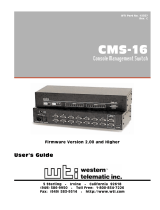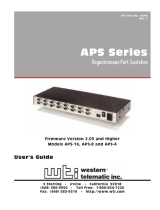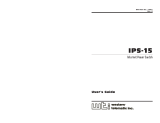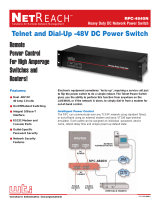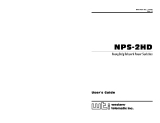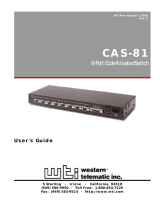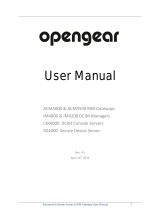Page is loading ...

RPC-4840N
Network Ready Remote Power Controller
User's Guide


Warnings and Cautions:
No Serviceable Parts Inside;
Authorized Service Personnel Only
Do not attempt to repair or service this device yourself. Internal
components must be serviced by authorized personnel only.
•
Shock Hazard - Do Not Enter
Nameplate Power Warning
This device should only be operated with the type of power
source indicated on the instrument nameplate. If you are not
sure of the type of power service available, consult your local
power company.
•
Connect unit only to a properly measured supply. Use
only three wire cord which is provided with the unit.
•
Reliable earthing of this equipment must be maintained.
Particular attention should be given to supply
connections when connecting to power strips, rather than
direct connections to the branch circuit.
Rack Mount Installation
When installing this device in an instrument rack, the following
factors must be accounted for:
1. Enclosed Racks: Enclosed racks must provide adequate
ventilation. Make certain that the rack is not overly
crowded and note that each unit in the rack generates its
own heat. An enclosed rack should have louvered sides
and a fan to circulate cooling air.
When mounting the unit in an enclosed rack with a
ventilation fan at the top of the rack, note that excessive
heat generated by devices at the bottom of the rack can be
drawn upward and into the ventilation slots of units
located at the top. Make certain to provide adequate
ventilation for equipment installed at the bottom of
the rack.
(Continued)

Rack Mount Installation (Continued)
1. Enclosed Racks (Continued):
The ambient within the rack may be greater than room
ambient. Installation should be such that the amount of air
flow required for safe operation is not compromised. The
maximum temperature for the equipment in this
environment is 45°C. Consideration should be given to the
maximum rated ambient.
Installation should be such that a hazardous stability
condition is not achieved due to uneven loading.
2. Open Racks: Make certain that the rack frame does not
block the ventilation slots on the instrument cover. If the
device is installed on sliders, check the unit when seated
all the way into the rack to make certain that ventilation
slots are not blocked.
Ventilation
Slots in the instrument cover are provided to allow ventilation
for heat dissipation. To ensure safe, reliable operation, these
openings must not be covered or blocked.
Disconnect Power
If any of the following events are noted, immediately disconnect
the unit from the power source and contact qualified service
personnel:
1. If the power cord becomes frayed or damaged.
2. If liquid has been spilled into the device or if the device
has been exposed to rain or water.

Table of Contents

List of Figures

1. Introduction
Network equipment sometimes "locks-up", requiring a service
call just to flip the power switch to perform a simple reboot. The
RPC-4840N Heavy Duty Remote Power Controller gives you the
ability to reboot DC powered equipment from anywhere on the
LAN/WAN, or if the network is down, to simply dial-in from a
modem for out-of-band power control.
Intelligent Power Control
The RPC-4840N can communicate over any TCP/IP network
using standard Telnet, or out-of-band using an external modem
and terminal emulation. Each DC circuit can be assigned an
individual password, device name, reboot delay time and unique
power-up default status.
Security
Address specific IP security masks prevent unauthorized users
from accessing the RPC command menu via network. The RPC
provides two separate password security levels; System level and
User level. The System password allows access to all
configuration and command functions. The User password
allows limited access to command functions.
Easy to Use, Easy to Configure
The RPC-4840N can be configured over the network, via modem,
or locally via the RPC Console Port. Easy-to-use commands let
you assign a location name, set system parameters and view
circuit status. Circuits can be switched On, Off, or Booted using
circuit numbers or user-defined names.
Heavy Duty DC Power Control
The RPC-4840N can control up to 40 amps of DC power per
circuit. Since larger routers require as much as 30 amps, the
RPC has power control to spare. The optional second Circuit
Module allows the RPC to control power for two 40 amp, DC
powered instruments.

Features:
·
Dual 40 Amp Circuits
·
On/Off/Reboot Switching
·
Integral 10Base-T Interface
·
RS232 Modem and Console Ports
·
Circuit-Specific Password Security
·
Network Security Features
·
Manual On/Off Buttons
Typographic Conventions
Throughout this manual, typefaces and characters have been used
to denote the following:
COURIER FONT Indicates characters typed on the keyboard.
For example, /ON 1 or /OFF 2.
[Bold Font] Text set in bold face and enclosed in
square brackets indicates a specific key.
For example, [Enter] or [Esc].

2. Unit Description
2.1. Front Panel
As shown in Figure 2.1, the RPC-4840N front panel includes a
series of LED indicators which function as follows:
À
ON: Lights when Power is applied to the Control Section.
Á
RDY: Flashes when the RPC-4840N is ready to receive
commands. Indicates that the Console Port has received
the "Ready" signal from the control device.
Â
RXD: Lights when the RPC-4840N receives commands.
Ã
Circuit 1 Indicator: Lights when the Circuit 1 Switch is
closed (Power ON to connected device.)
Ä
Circuit 2 Indicator: Lights when the optional Circuit 2
Switch is closed (Power ON to connected device.)
2.2. Back Panel
À
Network Port and Activity Indicator: A 10BaseT, RJ45
Ethernet port for connection to your TCP/IP network. To
communicate via network, you must first specify network
parameters as described in Section 5.6.
Note: The RPC-4840N features a 10BaseT interface.
When connecting the RPC to a 100BaseT interface, note
that most 100BaseT router switches will autosense to
determine if the device is 100BaseT or 10BaseT and then
configure the network interface accordingly. If your router
switch does not autosense, then the network interface port
must be manually set to 10BaseT.

Á
Options Switch: Four DIP Switches which set the default
baud rate, boot delay, echo mode, and timeout.
Â
Default Button: Used in conjunction with the Reset
Button to reset the unit to defaults (see Section 4.3.)
Ã
Console Port: A Male RS-232, DB9 Connector, DTE
configuration. For connection to a local PC.
Ä
Modem Port: A Male RS-232, DB9 Connector, DTE
configuration. For connection to an external modem.
Å
Reset Button: Used in conjunction with the Default
Button to reset the unit to defaults (see Section 4.3.)
Æ
Circuit Module 1: For connection to your DC power
supply and DC powered device. Each circuit is capable of
switching up to 40 Amps. Note that power for control
functions is also derived from the Circuit 1 input terminal.
A. ON Indicator: Lights when the corresponding Circuit
Module is switched On (switch closed).
B. Emergency Override Breaker: If the circuit is
overloaded, the breaker pops out and opens the circuit.
If necessary the Override Breaker can also be manually
pulled out to open the circuit. To reset the circuit,
press the Override Breaker in.
Ç
Circuit Module 2 (Optional): For connection to a second
DC power supply and DC powered device. Same as
Circuit Module 1.

3. Quick Start Guide
This section provides a brief overview of basic RPC-4840N
capabilities, and describes a simple test that can be performed to
determine if the unit is operating properly and demonstrate basic
communication capabilities.
Note that this Quick Start procedure is included only to provide a
quick demonstration of basic RPC-4840N capabilities. In order
to take full advantage of the complete range of features provided
by this unit, it is strongly recommended that you should complete
the entire Installation and Configuration sections after
completing the Quick Start procedure.
1. Apply Power to the RPC-4840N: Connect an appropriate
power source to the input terminals on the Circuit 1
terminal block, located on the RPC back panel. Prior to
connecting the unit to your power supply, make certain to
review the safety precautions listed at the beginning of this
User's Guide.
2. Connect a PC to the RPC-4840N: Attach a standard null
modem cable from your PC COM port to the Console Port
connector on the RPC back panel. For a description of the
port interface, please refer to Appendix A.
Note: When the RPC is shipped from the factory,
Console Port communication parameters are set as
follows: 9600 bps, 8 Data Bits, One Stop Bit, No
Parity. Although the RPC allows these parameters
to be easily redefined, for this Quick Start
procedure, it is recommended that you configure
your communications program to accept the default
parameters.
3. Access the Command Mode: Start your communications
program and then press [Enter]; the System Help Screen
should be displayed (Figure 3.1) and the "RPC>" command
prompt should appear. For more information on command
mode access, please refer to Section 5.2.

4. Configure Network Port: In order to communicate with
the RPC-4840N via the Network Port, you must first
define the IP Address, Subnet Mask, and Gateway
Address. At the RPC> command prompt, type /N and
press [Enter] to display the Network Parameters menu.
a) Settings for network parameters will depend on the
configuration of your individual network. Please
contact your network administrator to determine
appropriate settings for the IP Address, Subnet Mask,
and Gateway Address.
b) To assign network parameters, key in the number for
the desired parameter, press [Enter], and then follow
the instructions in the resulting submenu. For
example, to define the IP Address, type 1 and
press [Enter].

5. Exit Command Mode: When you have finished setting
Network Parameters, type /X and press [Enter] to exit the
command mode at the Console Port.
Note: Only one port may access the command
mode at a given time. In order to allow access to the
RPC unit via other ports, always exit from the
command mode when finished communicating with
the unit.
6. Connect Network Cable: Connect your network interface
to the RPC-4840N Network Port. The Network Port is an
RJ45, 10BaseT Ethernet jack, for connection to a TCP/IP
network.
Note: The RPC features a 10BaseT Interface.
When connecting to a 100BaseT interface, note that
most router switches will autosense to determine if
the device is 100BaseT or 10BaseT, and then
configure the network interface accordingly. If your
router switch does not autosense, then the network
interface port must be manually set to 10BaseT.
7. Network Access: Telnet to the RPC's IP address. For
example, if the IP address is "119.1.1.1", on a UNIX
system the Telnet command would be invoked as follows:
$ telnet 119.1.1.1 [Enter]
After the Telnet connection is established, the RPC should
display the System Help Screen and the RPC> command
prompt should appear, indicating that you have
successfully accessed the RPC Command Mode via the
Network Port.

8. Test Boot Commands: When the RPC-4840N is powered
up, both switched circuits will be set in the ON (closed)
position. In order to test for proper operation, you may
wish to perform the following test. Note that it is not
necessary to connect a device to either switched circuit in
order to perform this test.
a) Reboot Circuits: To initiate a boot cycle at both
circuits, go to the RPC> command prompt, type
/BOOT * and press [Enter]. Power to both circuits
will be switched OFF. After the Boot Delay Period
(Default = 5 Seconds), the power to both circuits will
then be automatically switched back ON. Note that the
Circuit Status Indicators on the RPC front panel will
also switch Off and On.
b) Switch Circuits OFF: To switch both circuits OFF, go
to the RPC> command prompt, type /OFF * and then
press [Enter]. Power to both circuits will be switched
OFF. Note that the Circuit Status Indicators will also
be switched Off.
c) Switch Circuits ON: To switch both circuits ON, go
to the RPC> command prompt, type /ON * and then
press [Enter]. Power to both circuits will be switched
ON. Note that the Circuit Status Indicators will also be
switched On.
9. Exit Command Mode: Type /X and press [Enter] to exit
from the RPC Command Mode, or disconnect using your
Telnet program.
This completes the introductory overview of the RPC-4840N.
Prior to installing and operating the unit, please review the
remainder of this User's Guide for important information
regarding safety considerations, as well as more detailed
installation, configuration, and operation instructions.

4. Installation
4.1. Power Connection
Connect your DC power supply to the Circuit 1 Input Terminals
as shown in Figure 4.1. Connect the power supply lines from
your DC Powered device to the Output Terminals. Note that the
RPC-4840N is available with two separate 40 amp circuits. In
order for both circuits to function, power must be connected to
both input connectors on the unit's back panel.
CAUTIONS:
•
This device should only be operated with the
type of power source indicated on the
instrument nameplate. If you are not sure of the
type of power service available, please contact
your local power company.
•
Reliable earthing (grounding) of this unit must
be maintained. Particular attention should be
given to supply connections when connecting to
power strips, rather than directly to the branch
circuit.
"Always On" Architecture: The RPC features "Always On"
architecture. This means that once the RPC is connected to your
power supply, both circuits will always be set in the ON state,
unless program commands are used to set the circuit(s) to
the OFF state.
Note: In addition to supplying power to the device
connected to Circuit 1, the Circuit 1 power input
also provides power for the RPC control section.

4.2. Option Switches
The Option Switches select default settings for the Baud Rate,
Command Echo, Boot Delay and Disconnect Timeout. Default
settings selected via the Option Switches will be used when the
unit is reset to default parameters as described in Section 4.3.
Notes:
•
Although the Option Switches select default
settings for these features, the RPC-4840N
configuration menus can also be used to select
operating parameters as described in Section 5.
•
If Option Switch settings are changed, the new
settings will not be applied until the unit is reset
as described in Section 4.3.
Option Switch settings are described below:
Baud Rate: The default baud rate for both the Console Port and
Modem Port.
Boot Delay: The default Boot Delay setting. When a boot cycle
is initiated, the Boot Delay determines the length of time each
switched circuit will remain off until power is restored.
Command Echo: The default setting for the Command Echo for
the Console Port, Modem Port and Network Port. When
enabled, commands entered at your keyboard will be sent to
the RPC and echoed back to your display monitor.
Disconnect Timeout: The default Disconnect Timeout value.
This determines how long the RPC will wait for additional
commands before automatically disconnecting. Note that
when the RPC times out, DTR will drop, and the modem
disconnect and initialize strings will be sent.
Switch Function Up Down
* = Factory Setting

4.3. Reset Unit to Defaults
If Option Switch settings are changed, the new settings will not
be applied until the unit is reset to default settings. There are
two ways to reset the unit to defaults:
Note: When these reset procedures are performed,
all user selected parameters, including passwords
and circuit names will be lost. Prior to performing
these reset procedures, it is strongly recommended
to save configuration parameters to an ASCII text
file as described in Section 7.
4.3.1. Default Button / Reset Button (Local)
Typically, this method is used when you have immediate access
to the installation site.
1. Simultaneously press the DEFAULT and RESET buttons,
located on the RPC Back Panel.
2. Release the RESET button, wait for approximately five
seconds, and then release the DEFAULT button.
4.3.2. Default Parameters Option
To reset the unit to default parameters using the General
Parameters Menu's "Default Parameters" option, proceed
as follows. Note that this method requires that you have already
connected a local or remote PC to the unit and have accessed the
command mode.
1. Access the RPC Command Mode (see Section 6.1).
2. At the RPC> command prompt, type /G and press [Enter].
The General Parameters menu will appear.
3. From the General Parameters menu, type A and press
[Enter]. If command confirmation is enabled, the unit
will display a "Sure?" prompt. Type Y and press [Enter]
to proceed with the reset procedure. After a brief pause,
parameters will be reset to default values.
Note: If the Default Parameters function is invoked
via the Network Port, the IP Address will not be
reset. If this function is invoked via the Console
Port or Modem Port, the IP Address will be reset.

4.4. Console Port Connection
The Console Port is a male, DB9 connector, wired in a DTE
configuration (similar to an AT style computer), which is used
for connection to a local PC or control device. Appendix A
describes the Console Port interface.
4.5. Connecting an External Modem
When connecting directly to an external modem, use a standard
DB9 AT to Modem cable. Section 5.4 describes the procedure
for defining the modem command strings. Appendix A describes
the modem port interface.
4.6. Connecting the Network Cable
The Network Port is an RJ45 Ethernet jack, for connection to a
TCP/IP network. Connect your 10Base-T cable to the Network
Port. Before attempting to access the unit via network, please
assign the IP Address, Gateway Address and Subnet Mask as
described in Section 5.6.
Note: The RPC features a 10BaseT interface.
When connecting the RPC to a 100BaseT interface,
note that most router switches will autosense to
determine if the device is 100BaseT or 10BaseT and
then configure the network interface accordingly. If
your router switch does not auto-configure for
10BaseT vs. 100BaseT, then the network interface
port must be manually set to 10BaseT.

5. Configuration
5.1. System Mode and User Mode
In order to restrict access to sensitive command functions, the
RPC-4840N features two separate operating modes; System
Mode and User Mode.
The System Mode allows access to all configuration menus,
command functions and status screens. When the System Mode
is active, Boot/On/Off commands can always be directed to
either of the two switched circuits, even if each circuit has been
assigned a separate password. The System Mode Status Screen
shows On/Off conditions for both switched circuits, and lists
currently defined system parameters.
The User Mode allows limited access to command functions and
status screens; users are not allowed to access configuration
menus. When the User Mode is active, Boot/On/Off commands
can only be directed to the specific circuit(s) allowed by the User
Password entered at login. If a different User Password is
assigned to each RPC circuit, then a user who accesses the RPC
using the password for Circuit 1 is not allowed to boot or switch
Circuit 2. On the other hand, if the same User Password is
assigned to both circuits, then that user will be able to direct
commands to both circuits. The User Mode Status Screen only
shows conditions at the circuit(s) owned by the User Password;
system parameters are not displayed.
When properly configured, the RPC will display a password
prompt when the unit is contacted via the Console Port, Modem
Port or Network Port. The password entered at this prompt
determines whether the unit will start-up in System Mode or User
Mode. If the System Password (defined via the General
Parameters menu) is entered, the System Mode will be active. If
the User Password (defined via the circuit Configuration Menus)
is entered, the User Mode will be active.
If the System Password is not defined, the RPC will not display
the password prompt, and will always start-up in System Mode.
Once the System Password has been defined, individual users can
be granted access by assigning passwords to the two switched
circuits as described in Section 5.5.

5.2. Communicating with the RPC-4840N
In order to configure the unit or invoke command functions, the
user must first connect to the RPC-4840N and access the
command mode.
1. The RPC is transparent to parity and will accept 7 or 8 bit
characters, but will always answer back at 8 bits, no parity.
Make certain your communication program (e.g.
HyperTerminal or ProComm) is set for the appropriate
baud rate, bits and parity.
a) Via Modem: Start your communications program.
Dial the external modem connected to the RPC. Wait
for the Connect message and proceed to Step 2.
b) Via Local PC: Start your communications program
and then press [Enter].
c) Via Network: During initial configuration, the RPC
cannot be accessed via the Network Port. After
network parameters have been defined (see
Section 5.6), the unit may then be accessed via network
as described in Section 6.1.
Note: Only one port can access the command mode
at a given time. When communicating via the
Console Port or Modem Port, always make certain to
disconnect (using the /X command) when you have
finished. If the Console Port or Modem Port are
busy, you will not be able to access the command
mode via the Network Port. For more information,
please refer to Section 6.7.
2. Password: If the System Password has been defined, the
unit will display the Password Prompt. Key in either the
System Password or User Password, and press [Enter].If
the system password has not been defined, the prompt will
not be displayed. Note that the Password feature is case
sensitive.
3. If the System Password is entered, the RPC will display
the System Help Screen (Figure 5.1). If the User Password
is entered, the User Help Screen (Figure 5.2) will be
displayed.
/
